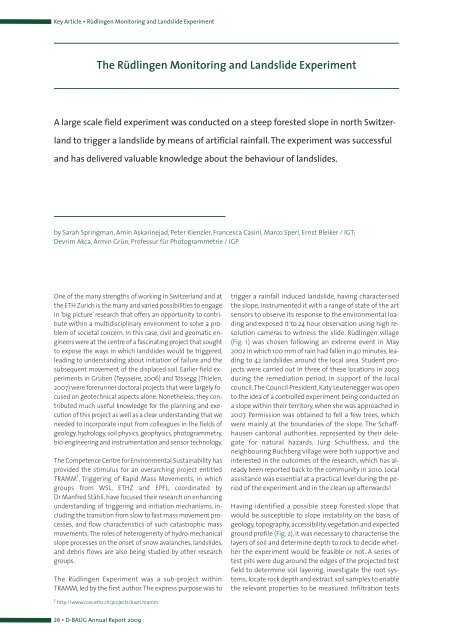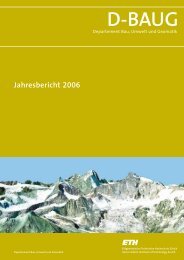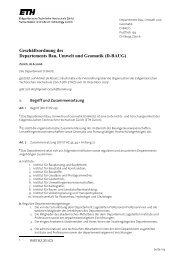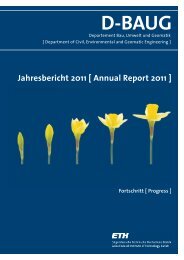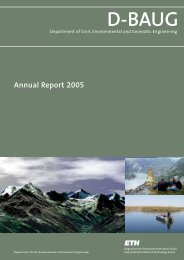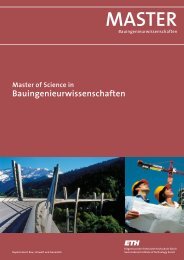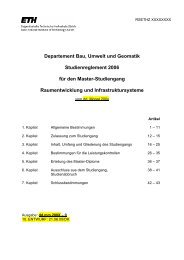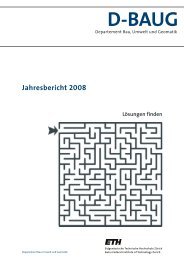D-BAUG - Departement Bau, Umwelt und Geomatik - ETH Zürich
D-BAUG - Departement Bau, Umwelt und Geomatik - ETH Zürich
D-BAUG - Departement Bau, Umwelt und Geomatik - ETH Zürich
Create successful ePaper yourself
Turn your PDF publications into a flip-book with our unique Google optimized e-Paper software.
Key Article ▪ Rüdlingen Monitoring and Landslide Experiment<br />
The Rüdlingen Monitoring and Landslide Experiment<br />
A large scale field experiment was conducted on a steep forested slope in north Switzer-<br />
land to trigger a landslide by means of artificial rainfall. The experiment was successful<br />
and has delivered valuable knowledge about the behaviour of landslides.<br />
by Sarah Springman, Amin Askarinejad, Peter Kienzler, Francesca Casini, Marco Sperl, Ernst Bleiker / IGT;<br />
Devrim Akca, Armin Grün, Professur für Photogrammetrie / IGP<br />
One of the many strengths of working in Switzerland and at<br />
the <strong>ETH</strong> Zurich is the many and varied possibilities to engage<br />
in ‘big picture’ research that offers an opportunity to contribute<br />
within a multidisciplinary environment to solve a problem<br />
of societal concern. In this case, civil and geomatic engineers<br />
were at the centre of a fascinating project that sought<br />
to expose the ways in which landslides would be triggered,<br />
leading to <strong>und</strong>erstanding about initiation of failure and the<br />
subsequent movement of the displaced soil. Earlier field experiments<br />
in Gruben (Teysseire, 2006) and Tössegg (Thielen,<br />
2007) were forerunner doctoral projects that were largely focused<br />
on geotechnical aspects alone. Nonetheless, they contributed<br />
much useful knowledge for the planning and execution<br />
of this project as well as a clear <strong>und</strong>erstanding that we<br />
needed to incorporate input from colleagues in the fields of<br />
geology, hydrology, soil physics, geophysics, photogrammetry,<br />
bio-engineering and instrumentation and sensor technology.<br />
The Competence Centre for Environmental Sustainability has<br />
provided the stimulus for an overarching project entitled<br />
TRAMM 1 , Triggering of Rapid Mass Movements, in which<br />
groups from WSL, <strong>ETH</strong>Z and EPFL, coordinated by<br />
Dr Manfred Stähli, have focused their research on enhancing<br />
<strong>und</strong>erstanding of triggering and initiation mechanisms, including<br />
the transition from slow to fast mass movement processes,<br />
and flow characteristics of such catastrophic mass<br />
movements. The roles of heterogeneity of hydro-mechanical<br />
slope processes on the onset of snow avalanches, landslides,<br />
and debris flows are also being studied by other research<br />
groups.<br />
The Rüdlingen Experiment was a sub-project within<br />
TRAMM, led by the first author.The express purpose was to<br />
1 http://www.cces.ethz.ch/projects/hazri/tramm<br />
26 ▪ D-<strong>BAUG</strong> Annual Report 2009<br />
trigger a rainfall induced landslide, having characterised<br />
the slope, instrumented it with a range of state of the art<br />
sensors to observe its response to the environmental loading<br />
and exposed it to 24 hour observation using high resolution<br />
cameras to witness the slide. Rüdlingen village<br />
(Fig. 1) was chosen following an extreme event in May<br />
2002 in which 100 mm of rain had fallen in 40 minutes, leading<br />
to 42 landslides aro<strong>und</strong> the local area. Student projects<br />
were carried out in three of these locations in 2003<br />
during the remediation period, in support of the local<br />
council.The Council President, Katy Leutenegger was open<br />
to the idea of a controlled experiment being conducted on<br />
a slope within their territory, when she was approached in<br />
2007. Permission was obtained to fell a few trees, which<br />
were mainly at the bo<strong>und</strong>aries of the slope. The Schaffhausen<br />
cantonal authorities, represented by their delegate<br />
for natural hazards, Jürg Schulthess, and the<br />
neighbouring Buchberg village were both supportive and<br />
interested in the outcomes of the research, which has already<br />
been reported back to the community in 2010. Local<br />
assistance was essential at a practical level during the period<br />
of the experiment and in the clean up afterwards!<br />
Having identified a possible steep forested slope that<br />
would be susceptible to slope instability on the basis of<br />
geology, topography, accessibility, vegetation and expected<br />
gro<strong>und</strong> profile (Fig. 2), it was necessary to characterise the<br />
layers of soil and determine depth to rock to decide whether<br />
the experiment would be feasible or not. A series of<br />
test pits were dug aro<strong>und</strong> the edges of the projected test<br />
field to determine soil layering, investigate the root systems,<br />
locate rock depth and extract soil samples to enable<br />
the relevant properties to be measured. Infiltration tests


